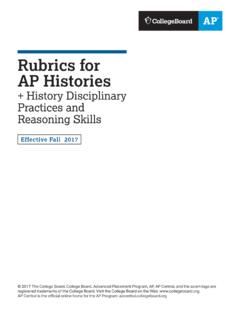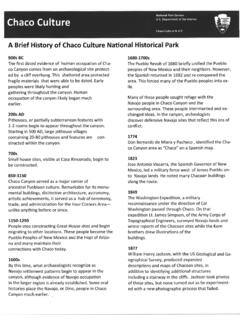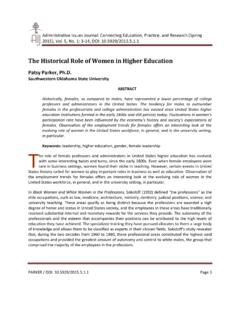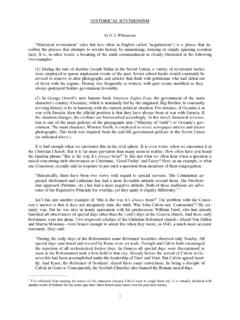Transcription of A HISTORICAL ANALYSIS OF SPECIAL EDUCATION SERVICES IN
1 A HISTORICAL ANALYSIS OF SPECIAL EDUCATION . A HISTORICAL ANALYSIS OF SPECIAL EDUCATION SERVICES IN. CONSERVATIVE CHRISTIAN SCHOOLS SINCE 1950. A thesis proposal submitted in partial fulfillment for the requirements of the degree Masters of EDUCATION By KRISTI-LYNN CRAIG. Early Childhood EDUCATION , Cedarville University, 2003. SPECIAL EDUCATION , Cedarville University, 2003. 2010. Cedarville University Running Head: A HISTORICAL ANALYSIS OF SPECIAL EDUCATION . ABSTRACT. Craig, Kristi-Lynn , EDUCATION Department, Cedarville University, 2010. A HISTORICAL ANALYSIS of SPECIAL EDUCATION SERVICES in Conservative Christian Schools since 1950. This study examines the HISTORICAL progression of the availability of SPECIAL EDUCATION in Conservative Christian Schools in the United States since 1950.
2 Due to the limited nature of research in this field, a HISTORICAL ANALYSIS was used to better understand how the development of SPECIAL EDUCATION in Conservative Christian Schools compares to the development of SPECIAL EDUCATION in Public Schools. After analyzing the literature, four key turning points were identified. In addition, the significant roles of funding and Biblical support were examined. This thesis made recommendations for future, continued research and poses suggestions for Conservative Christian Schools to consider regarding the development of SPECIAL EDUCATION programs. Limitations to the study were noted. iii A HISTORICAL ANALYSIS OF SPECIAL EDUCATION . TABLE OF CONTENTS. I. Introduction to the Study .. 1. Definition of Terms ..4. Statement of the Problem.
3 6. Scope of the Study and Significance of study .. 10. Methods of Procedure .. 11. II. Plenary Literature Review .. 13. Pre- SPECIAL EDUCATION .. 13. Dormant period .. 16. Abandoning the Public School .. 16. Establishment of IDEA .. 19. The State of Contemporary Conservative Christian School SPECIAL EDUCATION .. 24. Summary .. 31. III. 33. Introduction to the 33. Rational for the Method .. 34. 34. iv A HISTORICAL ANALYSIS OF SPECIAL EDUCATION . IV. Results and ANALYSIS .. 37. Introduction .. 37. Description and ANALYSIS of the Key Turning Points .. 38. Conclusions .. 49. V. Discussion and 54. HISTORICAL Summary .. 54. Biblical Integrative Component & Implications .. 56. 58. Conclusions .. 70. Strengths of the Study .. 72. Limitations of the Study .. 73. Suggestions for Further Research.
4 74. VI. References .. 77. v A HISTORICAL ANALYSIS OF SPECIAL EDUCATION . Introduction The 1954 Supreme Court decision in Brown v. Board of EDUCATION began the process of providing equal educational access to all students in the United States (Harding, 2009). Prior to this decision, the segregation of EDUCATION included both race and students with disabilities. Brown v. Board of EDUCATION affirmed the idea that separate is inherently not equal. After a century of experience with residential institutions and wrestling with SPECIAL EDUCATION programs in the public schools, educators of children with disabilities acquired the background and opportunity to reflect on their experiences (Osgood, 2008). Prior to Brown v. Board of EDUCATION and continuing through this pivotal decision, there were several events and laws that pushed SPECIAL EDUCATION into the public eye.
5 While Brown was most influential, it was only one part of a series of events to draw the public's attention to SPECIAL EDUCATION . In the 1930's and 1940's, published observations by educators of SPECIAL EDUCATION brought a critical eye to the current status of SPECIAL EDUCATION as well as the needed change. As information exposed the condition of EDUCATION provided to individuals with disabilities, advocates worked to create equal educational rights for students with disabilities. Seventy-two percent of children with disabilities were not enrolled in public school in 1950, but were either kept home or institutionalized (Anderson et. al., 2001a). It took several decades for SPECIAL EDUCATION in public schools to come into being. Section 504 of The Rehabilitation Act of 1973 states that discrimination cannot occur based on a child's disability (Osborne &.)
6 Russo, 2006). 94-142 (the EDUCATION of All Handicapped Children Act) passed in 1. A HISTORICAL ANALYSIS OF SPECIAL EDUCATION . 1975. This significant decision changed how public school children with disabilities were viewed and educated. When 94-142 was reauthorized in 1990, as 101-476, it was renamed the Individuals with Disabilities EDUCATION Act, or IDEA (Kluth, Villa, &. Thousand, 2001). IDEA required students to meet three requirements in order to receive SPECIAL EDUCATION SERVICES : (1) a child must be between the ages of 3 and 21, (2). a child must have a specifically identified disability, and (3) a child must be in need of specially designed instruction in the least restrictive environment (Osborne & Russo, 2006). According to IDEA, the construct of least restrictive environment requires that, to the greatest extent possible, children with disabilities should be educated with their nondisabled peers and the removal of children with disabilities from the regular EDUCATION classroom should only happen when EDUCATION in regular classes cannot be reasonably achieved with the addition of aids and SERVICES (United States Department of EDUCATION , 2007).
7 The two most recent laws passed that affect SPECIAL EDUCATION SERVICES are the No Child Left Behind Act (2001), which gave greater accountability to the EDUCATION of students in both general and SPECIAL EDUCATION , and the 2004. reauthorization of IDEA (renamed IDEIA, the Individuals with Disabilities EDUCATION Improvement Act). IDEIA, the most recent reauthorization of IDEA, attempted to clarify the responsibilities of the public school to children with disabilities placed by their parents in private schools. Public schools are required, by law, to seek out, evaluate, and collaborate with private institutions in order to ensure that children with disabilities are receiving the supports and helps needed to succeed (Drang and McLaughlin, 2008). 2. A HISTORICAL ANALYSIS OF SPECIAL EDUCATION .
8 Clarifying the relationship of private schools to funding for students with disabilities was another focus of the reauthorization. It is unclear why private schools report that low numbers of their students receive evaluations, diagnoses, and individualized EDUCATION plans (IEPs) even when there are SPECIAL EDUCATION programs available for students within the private institution (Eigenbrood, 2005). As legislation brought changes to SPECIAL EDUCATION programs in public schools, the growth of conservative Christian schools (independently) increased. In 1900, approximately million students were enrolled in private schooling options, primarily Catholic institutions (Jones, 2008). Questions regarding the nature of schooling specifically who should provide EDUCATION to children in the United States.
9 Caused conflict between states and some parents. The 1925 Supreme Court decision, Pierce v. Society of Sisters, established the right of parents to choose to have their children educated at a religiously affiliated institution (Russo, Osborne, Massucci, &. Cattaro, 2009). Prior to this decision, Oregon law had required that students ages 8-16. attend public school. The Supreme Court decision in Pierce was pivotal for the future development of private educational facilities. Since the 1960's, evangelical Christians have been active in establishing alternative educational settings (Jones, 2008). Some protestant Christians shifted their loyalties away from public schools when they felt their beliefs and moral values were being taken out of school and replaced by a humanistic secular religion (Carper &.)
10 Layman, 2002). Supreme Court decisions in 1962 and 1963, removing prayer and devotional Bible reading from public schools, encouraged the growing dissatisfaction 3. A HISTORICAL ANALYSIS OF SPECIAL EDUCATION . among many Christians. Between 1971 and 1981 the number of conservative Christian schools rose from 140,000 to 450,000 (Jones, 2008). By the year 2000, approximately million students were enrolled in private schooling options (this included homeschooling). The number of students enrolled in private institutions or homeschooled continues to rise, illustrating what many experts believe to be a growing lack of trust toward public EDUCATION (Carper & Layman, 2002). In this context, parents have claimed their right to choose how their children will be educated.















